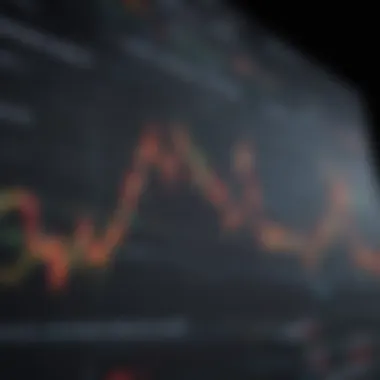Home Trading: A Comprehensive Guide for Investors


Intro
The landscape of home trading has undergone a seismic shift in recent years, becoming more accessible than ever before. The advent of technology, especially mobile applications and online trading platforms, means that anyone with an internet connection can become an active participant in the financial markets. This democratization of trading is not without its complexities and challenges, as beginners may find themselves navigating a maze of jargon and strategies with little guidance.
As this article unpacks the world of home trading, it's imperative to grasp the key concepts and definitions essential for understanding this dynamic field. Whether you are just dipping your toes in or you're a seasoned player looking to enhance your game, this guide aims to illuminate the significant components of home trading, the strategies involved, and the tools necessary to thrive.
Key Concepts and Definitions
Understanding the lingo surrounding trading is crucial.
Overview of Investment Terms
When diving into home trading, various terms are tossed around like confetti, often leaving newcomers scratching their heads. Here are some foundational terms worth knowing:
- Broker: An individual or firm that executes trades on behalf of clients. In the digital age, many brokers operate through online platforms.
- Market Order: This is an order to buy or sell a security immediately at the current market price. It is the simplest type of order and essential for quick trades.
- Limit Order: Unlike the market order, a limit order sets a specific price at which you want to buy or sell a security. This adds a layer of control over trading execution.
- Portfolio: A collection of financial assets, like stocks, bonds, or other investments, held by an individual or institution, showcasing the variety in one's investment strategy.
These terms form the backbone of trading discussions and can empower you in conversations, enhancing your confidence when making trading decisions.
Significance of Understanding Financial Terminology
Understanding financial jargon can be seen not just as a tool, but almost like a toolkit in itself. Ignoring these terms may lead to miscommunication and poor decision-making in your investment journey. For instance, grasping the differences between a market order and a limit order can mean the difference between seizing a great buying opportunity or missing out entirely.
"The better you understand the strategies and terms, the more robust your trading decisions will be."
Familiarity with these concepts lays the groundwork for deeper exploration into more intricate strategies and market behaviors. In the sections to come, we will delve into various investment strategies suitable for both beginners and more advanced traders alike, ensuring a comprehensive perspective on home trading.
Expert Insights and Advice
Moving beyond the basics, it's time to explore the strategies that can help both novices and veterans sharpen their trading skills.
Investment Strategies for Beginners
When starting out, the aim isn't to hit a home run with each trade. Instead, focus on establishing a solid foundation by implementing these strategies:
- Research Before You Leap: Spend time exploring different companies and sectors. Knowledge can significantly mitigate risks while enabling informed decisions.
- Start Small: Investing a small amount initially allows you to familiarize yourself with market fluctuations without risking your entire capital.
- Keep Emotions in Check: Trading can be a rollercoaster ride, with highs and lows that can trigger impulsive decisions. Sticking to a predetermined strategy can help combat emotional trading.
Advanced Techniques for Seasoned Investors
For those who have weathered the storm and are ready to elevate their trading strategies, the following advanced techniques may offer new avenues:
- Short Selling: This involves borrowing shares of a stock to sell them at current market prices with the intention of buying them back at a lower price. It’s a strategy laden with risk, best approached with caution.
- Utilizing Technical Analysis: This method uses past price movements and trading volume to forecast future price trends. Tools like moving averages and trend lines can guide market entry and exit points.
By understanding these strategies, traders can refine their approach and adapt to the ever-changing conditions within the market.
The journey through home trading is both intricate and rewarding. Armed with the right knowledge and a keen understanding of financial terminology, investors are better positioned to navigate the tumultuous waters of the financial markets.
Prelims to Home Trading
Home trading has surged in popularity over the last few decades, reshaping how individuals interact with financial markets. This transformation allows everyday people to step into the world of trading, a space once dominated by institutional investors and financial professionals. Understanding home trading is pivotal, as it offers a gateway to financial independence and empowers investors to take control of their financial destinies. The growth of technology and the democratization of information have played crucial roles in this shift, enabling anyone with an internet connection to engage in trading.
This article will explore the ins and outs of home trading, focusing on its mechanisms, advantages, challenges, and the technological revolution that has facilitated its rise. From novice investors seeking a foothold to seasoned traders aiming to refine their strategies, this guide lays the groundwork for informed decision-making.
Defining Home Trading
At its core, home trading refers to the act of buying and selling financial instruments, such as stocks and bonds, directly from the comfort of one’s home. This is typically achieved through online trading platforms that connect individuals to the live markets. Home traders can operate in real-time, reacting swiftly to market changes with just a few clicks on their computers or mobile devices.
To unpack the definition, let's look at its key components:
- Accessibility: Home traders no longer need to rely on brokers or financial advisors to execute their trades.
- Control: Individual investors decide when and how to trade, giving them direct influence over their investments.
- Variety: They have access to a plethora of financial products ranging from stocks to cryptocurrencies, catering to diverse investment strategies.
In summary, home trading allows individual investors to participate in financial markets without traditional barriers, paving the way for a more inclusive investing landscape.
The Evolution of Home Trading
The history of home trading is a tale of technological advancement and regulatory change. Back in the day, trading was an arduous process laden with phone calls to brokers during business hours. Investors had limited access to market insights, often missing out on lucrative opportunities.
However, the advent of the internet in the late 1990s was a game-changer. The introduction of online brokerage firms, such as E*TRADE and Charles Schwab, opened the floodgates for public access to trading resources. Key shifts included:
- Advancements in Technology: With the rise of personal computers and high-speed internet, trading became instant and more efficient.
- Investment Education: Internet-based resources offered people information and education, enabling them to learn at their own pace.
- Fee Reduction: Online brokers slashed commissions, enticing everyday people to dive into trading without the burden of exorbitant costs.


As a result, the face of trading transformed dramatically. Today, home trading is characterized by not only lower costs and enhanced access but also a sense of community, with social media platforms giving people shared spaces to discuss strategies and insights. This evolving landscape illustrates a shift toward greater democratization of finance, where anyone can position themselves to succeed in the markets.
The Mechanics of Home Trading
Understanding the mechanics of home trading is essential for investors who want to navigate this dynamic landscape effectively. It's not merely about clicking buttons on a trading platform; it involves comprehending how financial markets operate, choosing the right tools for your needs, and understanding how orders are executed in real-time. Mastering these elements can help reduce risks, maximize returns, and empower traders to make informed decisions.
Understanding Financial Markets
Financial markets are bustling environments where assets like stocks, bonds, and commodities are exchanged. They function like a marketplace, except the goods being traded are financial instruments. To successfully participate, traders have to get a grip on market fundamentals, such as supply and demand, market sentiment, and economic indicators.
Each market has its characteristics. For example, the stock market might be influenced by corporate earnings, while commodities can be swayed by geopolitical events. Being aware of these influences can help traders adjust their strategies. Additionally, it’s crucial to consider the types of market participants, from day traders to institutional investors, as their activities can ripple through the market.
"Investing without understanding the market is like sailing without a compass."
Trading Platforms and Tools
Choosing the right trading platform can feel like finding a needle in a haystack, given the plethora of options available today. Each platform comes with its features, and selecting one that aligns with your trading style can have a significant impact on your success.
Here are some vital elements to consider when evaluating trading platforms:
- User Interface: It should be intuitive and easy to navigate, reducing the learning curve.
- Charting Tools: Effective analysis often hinges on quality charts, so having robust tools at your disposal is essential.
- Market Access: Not all platforms provide access to every asset class; ensure the platform allows you access to the markets you wish to trade.
- Costs: Be mindful of commissions and fees; they can eat into profits faster than you think.
Some popular platforms in the home trading sphere include TD Ameritrade, E*TRADE, and Robinhood, each offering distinct features. It’s worthwhile to explore whether mobile apps provide seamless functionalities as they increasingly become a staple for many traders looking to keep their trading agile.
Order Types and Execution
Understanding order types is crucial when engaging in home trading, as it significantly affects how trades are executed and at what price. Here’s a breakdown of common order types:
- Market Orders: Buying or selling an asset immediately at the current market price. Fairly straightforward but may lead to unexpected executed prices in volatile markets.
- Limit Orders: Setting a specific price for buying or selling. This can help ensure that trades are executed at desired price points, but there’s always a risk that the trade will not be executed if the market never reaches the limit price.
- Stop Orders: Designed for risk management, these orders are triggered when the price hits a specified amount and can help prevent additional losses.
Beyond the types, execution speed is another critical component. In fast-moving markets, any lag in order execution can lead to substantial differences in trading outcomes. Monitoring your connection and ensuring you're on a reliable platform can help mitigate this risk.
Mastering the mechanics of home trading is not a one-size-fits-all endeavor. It requires time, patience, and dedication. Yet, as the adage goes, "practice makes perfect"—this remains true in the world of trading. Each trader will ultimately chart their own course through this complex landscape.
Advantages of Home Trading
Home trading offers several appealing benefits that attract both novice and seasoned investors alike. With the rise of technology and the internet, the home trading landscape has changed significantly, providing a unique opportunity that didn’t exist in the past. As we delve into specific advantages such as accessibility, cost-effectiveness, and a wide array of investment options, it becomes clear why many are drawn to trading from their own space.
Accessibility and Flexibility
One of the most significant perks of home trading is the accessibility it presents. Gone are the days when one has to be seated at a trading desk in a crowded brokerage firm. Nowadays, anything you need for trading can be achieved right from your home, or even on the go. This brings a sense of flexibility that is particularly valuable for those juggling multiple commitments.
The ability to trade during market hours from virtually anywhere allows for a more personalized trading experience. Individuals can choose the environment that suits them best, be it a quiet room or a bustling café. With just a laptop or mobile device, you gain control over when and how you engage with the market. Consider the ability to keep an eye on your trades while commuting or sneaking a quick session during lunch breaks. It’s like having your own trading office that fits right in your pocket.
Cost-Effectiveness
When you take a closer look at home trading, cost-effectiveness quickly stands out. Many platforms offering home trading come with lower fees and commissions than traditional brokerages. Perhaps the most captivating part is that substantial capital isn't needed to start trading from home, allowing even those with modest funds to dive in.
Consider this: instead of paying a premium for brokerage services, home traders can often access no or low-cost options. This can lead to substantial savings over time, enabling investors to funnel more money into their trades instead of allowing it to dwindle away on fees. Lower overhead makes home trading an attractive choice, especially for those new to the investment world who may not have a wealth of resources.
Variety of Investment Options
Another major advantage is the variety of investment options available to home traders. Unlike earlier times, where options seemed limited to a handful of assets, modern platforms now provide access to a mind-boggling range of instruments—from stocks and bonds to commodities and cryptocurrencies. The finger is essentially on the pulse of numerous markets, making it easier to diversify portfolios and mitigate risk.
Traders can experiment with various strategies across different asset classes, providing room for learning and growth. Here’s what might catch a trader's eye:
- Forex Trading: Potentially high liquidity and opportunities for quick trades.
- Cryptocurrencies: The burgeoning digital assets market allows traders to explore unprecedented volatility.
- Options and Derivatives: A way to leverage positions without the necessity of owning the underlying asset.
This boundless selection means that investors can tailor their portfolios to fit both their interests and risk tolerance. Home trading is no longer confined to stocks alone, opening up pathways for enhancing investment potential.
"Access to multiple market segments empowers individuals to make choices tailored to their financial dreams."
In short, the advantages of home trading can feel overwhelming in a delightful way. Accessibility, cost-effectiveness, and a treasure trove of investment options together create an enticing reasoning for taking the plunge into the world of home trading. The lure of having everything set up in one's own environment, hands-on control over finances, and potential for adaptability brings a modern flavor to investing. As we unfold the subsequent sections, these core benefits will organically lead into discussions about the challenges and strategies that accompany this approach.
Challenges in Home Trading
Home trading, while brimming with possibilities for profits and autonomy, comes with its fair share of hurdles. Understanding the challenges associated with trading from home is crucial for anyone looking to step into this world, whether they are a rookie or a seasoned trader. Addressing these challenges not only prepares an investor for the potential pitfalls but also provides insight into developing strategies that can mitigate risks. From unpredictable market swings to the psychological toll of investing, acknowledging these challenges can make a significant difference in one’s trading journey.
Market Volatility


Market volatility is perhaps the most daunting challenge that home traders face. The stock market can swing wildly based on a myriad of factors, including economic indicators, geopolitical events, or even corporate news. Traders who lack experience may find it difficult to navigate these fluctuations and make informed decisions under pressure.
In times of high volatility, prices can change in an instant, which might create a sense of urgency to act quickly. However, this can lead to rash decisions, resulting in losses instead of gains. Traders must develop a keen awareness of market conditions and be prepared for the unexpected. An effective way to cope with this volatility is to establish defined trading strategies that consider potential market shifts.
"The stock market is filled with individuals who know the price of everything, but the value of nothing."
Emotional and Psychological Factors
Trading from home is as much about mindset as it is about market knowledge. Emotional and psychological factors play a significant role in shaping a trader's decisions. Fear and greed can often cloud judgment, leading to erratic trading behavior. A trader who fears missing out may jump into lucrative opportunities recklessly, while one paralyzed by fear may miss out on solid trades.
Moreover, the isolation of home trading can exacerbate emotional strain. Unlike a bustling trading floor where traders can share experiences and advice, individuals working from home may feel lonely, further complicating their ability to analyze trades rationally. Developing emotional intelligence and understanding one’s psychological triggers is vital for maintaining composure in the face of market stress.
Technical Issues and Downtime
In today’s digital age, home traders rely heavily on technology for executing trades and analyzing markets. However, this dependence comes with its own set of challenges. Technical glitches, system outages, or even slow internet connections can lead to missed opportunities or unwanted consequences. Such disruptions can be particularly distressing during high-stakes trading moments when timing is everything.
To mitigate these concerns, traders should consider investing in reliable technology. This might include choosing a reputable trading platform that prioritizes uptime and has a responsive customer service team. Additionally, having backup systems in place, such as alternative devices or additional internet connections, can serve as a safety net during outages.
Essential Strategies for Home Trading
In the ever-evolving landscape of finance, having a solid game plan is not just advisable, it’s absolutely crucial. Home trading brings with it a slew of opportunities but also dramatic risks, so deploying sound strategies becomes paramount. These essential strategies serve as the backbone for both fledgling investors and seasoned traders alike, helping them to navigate the twists and turns of the market with more confidence.
Fundamental Analysis
Fundamental analysis involves evaluating a company's intrinsic value based on a mix of quantitative and qualitative factors. Investors delve into things like earnings reports, balance sheets, and the overall health of the industry to make informed decisions about buying or selling stocks.
It's about peering beneath the surface of stock prices, catching a glimpse of what fundamentally drives a company's success or failure. For instance, a trader looking at a tech stock might examine the growth potential of the technology sector, competitive advantages, or shifts in consumer behavior. It’s this type of analysis that empowers an investor to make choices backed by solid data rather than mere market musings.
Technical Analysis
Technical analysis is often likened to reading the pulse of the market. By analyzing price movements and trading volumes through charts and patterns, traders attempt to predict future market behavior. This strategy hinges on the belief that market trends and price movements can signal upcoming opportunities.
A common tool used in technical analysis is the moving average, which smooths out price data by creating a constantly updated average price. If a stock's price crosses above its moving average, it may be seen as a bullish signal, prompting traders to consider purchasing.
"In the world of trading, understanding market trends is akin to reading the wind before setting sail."
Risk Management Techniques
Every seasoned trader knows that risk management isn’t just about avoiding losses—it's part of building a sustainable trading strategy. Techniques such as setting stop-loss orders can help minimize losses on bad trades. A stop-loss order automatically triggers a sale when a stock hits a certain price, limiting the potential for further loss.
Additionally, traders might consider the use of position sizing, which involves determining how much capital to allocate for each trade based on the level of risk they're willing to accept. By spreading investments across different sectors or assets, one can help cushion the blow from unavoidable losses.
Developing a Trading Plan
A carefully crafted trading plan serves to tie it all together, setting out clear goals, rules, and strategies. A solid plan details entry and exit points, allocation of resources, and predefined risk management measures. This structured approach can minimize emotional decision-making during high-stress market conditions.
Ultimately, sticking to a trading plan not only fosters discipline but also encourages continuous performance analysis, making it easier to refine strategies over time. As the old saying goes, failing to prepare is preparing to fail, and in trading, those words ring especially true.
The Role of Technology in Home Trading
In the modern landscape of finance, technology plays a pivotal role in shaping how traders operate from the comfort of their homes. The rapid advancement of technology has not just simplified trading tasks, it has fundamentally transformed them. With innovations like mobile applications, algorithmic trading, and social media engagement, investors can access markets faster and more efficiently than ever before. This section delves into specific technological developments that foster a more engaging and streamlined trading experience, making it crucial for any trader to adapt to these changes.
Mobile Trading Applications
Mobile trading applications have revolutionized how individuals embark on trading. Gone are the days when you needed a desktop computer and a clunky software setup. Now, with just a smartphone, traders can check stock prices, execute trades, and manage portfolios on the go. This mobility means that opportunities won’t slip through fingers just because one isn't sitting in front of a computer screen.
Many of these apps come with customizable alerts. Traders can set notifications to inform them about significant market changes or even specific stock movements. This capability to react quickly can be a game-changer, especially in volatile markets where every second counts. Some popular mobile trading apps include Robinhood and E*TRADE, which offer user-friendly interfaces that appeal to both novices and seasoned professionals.
Algorithmic Trading
Algorithmic trading is a powerful tool that uses mathematical models and formulas to execute trades based on predetermined criteria. This technology minimizes human error and emotional involvement, which can often skew judgment. By relying on algorithms, traders can analyze vast amounts of data far quicker than a human could ever manage. In practice, a trader can set parameters, such as buying a stock when it hits a specific price, and the underlying technology does the rest.
"Using algorithms not only automates trades but also enhances the precision of executing strategies. Traders can focus on analysis rather than mechanics, which streamlines the process considerably."
However, it's worth noting that algorithmic trading also has its risks. Markets can move unpredictably, and algorithms might not always adapt to sudden changes or crises. As such, a fundamental understanding of market conditions remains essential.
The Impact of Social Media
Social media has recently emerged as a critical player in trading dynamics. Platforms such as Twitter, Reddit, and Facebook facilitate the rapid spread of information, opinions, and trends. Traders are increasingly turning to these platforms to gauge sentiment and anticipate market movements. For instance, the GameStop saga exemplified how collective trading activity, fueled by social media discussions, could spark a rally and challenge institutional investors.


Investors can find communities that share insights, strategies, and real-time updates on market conditions. Engaging with these groups can provide another layer of information that might not be readily available through traditional channels. However, it's essential to approach social media recommendations with a healthy dose of skepticism. Misleading information can travel fast, and it’s crucial for traders to conduct their diligence when acting on tips from social networks.
Navigating Regulatory Landscapes
Home trading, while empowering individual investors, comes intertwined with a web of regulations that require careful navigation. Understanding this terrain not only helps traders avoid pitfalls but also enables them to leverage opportunities while remaining compliant. In this section, we will explore key elements of regulatory landscapes, the benefits of comprehension, and the considerations that traders must keep in mind.
Understanding Compliance Requirements
When dipping your toes into home trading, compliance is your first line of defense. Regulatory bodies like the Securities and Exchange Commission (SEC) or Financial Conduct Authority (FCA) set rules designed to promote fair trading practices and protect investors from fraud.
Some key areas of compliance include:
- Licensing: Depending on your location and the type of trading you're pursuing, specific licenses may be necessary for operating legally. It’s prudent to check local regulations.
- Reporting requirements: Many jurisdictions ask traders to disclose specific financial activities. Check your local provisions to ensure you're meeting all necessary reporting criteria.
- Anti-money laundering (AML) laws: Engaging with platforms may require you to undergo Know Your Customer (KYC) checks. This helps prevent illicit activities that could tarnish your trading experience, while also ensuring your investments remain ethical.
Being abreast of these compliance requirements can save traders from potential legal issues that may hinder their journey in home trading.
The Importance of Investor Protection
Diving into home trading without the right awareness could leave investors vulnerable to risks, including scams and market manipulation. Regulatory measures, crafted with care, aim to shield investors through several mechanisms:
- Education: Many regulatory bodies provide resources to educate investors on safe trading practices, market fundamentals, and the associated risks. Leveraging these resources can enhance your trading knowledge.
- Dispute resolution: If things go awry, regulatory bodies often offer platforms for resolving disputes between traders and financial institutions. This added layer of security can give peace of mind when making investments.
- Market surveillance: Regulators actively monitor markets to catch any suspicious activity. Such oversight reduces the chances of market manipulation which can destabilize trading conditions.
In essence, being informed about regulatory frameworks not only assists in fostering a safer trading environment but also empowers the individual investor to make sound decisions. By understanding the rules of the game, traders can better position themselves for success while mitigating risks.
"Investing without regulations can be like sailing without a compass; you might reach the shore, but the journey could be fraught with risks you didn't see coming."
As home trading continues to flourish, an acute awareness of regulatory landscapes can only serve to solidify the position of individual investors in a dynamic financial ecosystem. The road may seem convoluted, but knowledge is a powerful tool in steering towards fruitful investment outcomes.
Future Trends in Home Trading
Understanding the shifting landscape of home trading is paramount for anyone who dabbles in the financial markets. As the marketplace evolves, recognizing these trends not only helps in adapting strategies but also in seizing new opportunities. Home trading is becoming more dynamic with technological advancements and broader socio-economic shifts, thus exploring these future trends is essential to remain competent in trading strategies.
Decentralized Finance
Decentralized finance, often referred to as DeFi, is a notable trend reshaping how individuals engage with financial markets. At its core, DeFi leverages blockchain technology to recreate and innovate financial services, allowing for greater transparency and lower barriers to entry for retail traders. In contrast to traditional finance, where intermediaries often siphon off profits, DeFi facilitates peer-to-peer transactions. This can lead to lower costs and faster transactions.
- Benefits of DeFi:
- Permissionless Access: Anyone with an internet connection can trade, irrespective of geographic location or bank affiliations.
- Smart Contracts: These are self-executing contracts with the terms of the agreement directly written into lines of code, which cuts out the need for manual intervention and reduces counterparty risk.
- Yield Farming: Engaging in DeFi protocols can offer opportunities for earning interest or rewards simply by holding certain crypto assets in a decentralized platform.
However, it’s important to choose DeFi projects wisely, as the lack of regulation can also lead to hacking incidents or scams. Overall, DeFi's rise can be a double-edged sword; it presents both immense potential and significant risk, which traders should carefully consider.
Artificial Intelligence in Trading
Artificial intelligence (AI) has been a significant game changer in stock trading, and its role is only expected to increase. AI’s ability to analyze vast datasets swiftly enables traders to gain insights that would be humanly unfeasible. From algorithmic trading systems to predictive analytics, AI provides tools for traders to make decisions based on real-time data.
- Impacts of AI in Trading:
- Market Predictions: Machine learning models can predict market trends with impressive accuracy, helping traders capitalize on upcoming movements.
- Automated Trading: AI can execute trades at breakneck speeds, often completing complex strategies in seconds, something human traders cannot match.
- Risk Assessment: Advanced algorithms are capable of pinpointing potential risks based on historical data, giving traders a clearer idea of how to manage their portfolios.
"In trading, where every second matters, relying on AI could be your most significant advantage."
As exciting as AI's integration is, it comes with its own set of challenges. Algorithmic trading can lead to flash crashes if not properly monitored, and there's concern around the accountability of automated systems. Thus, while engaging with AI tools, home traders should maintain a level of oversight to ensure that they remain in control.
In summary, the future of home trading is aligning closely with advancements in decentralized finance and artificial intelligence. Both trends offer groundbreaking opportunities while also presenting challenges that traders must navigate. Adapting to these trends will enhance the chances of success in the ever-evolving world of home trading.
Culmination and Key Takeaways
In the realm of investments, home trading has emerged as a prominent way to engage with financial markets. The conclusion of this exploration serves as a vital touchstone, summarizing the major insights gleaned throughout the article. Understanding home trading is not merely about knowing how to place an order or set up a trading account; it intertwines a holistic grasp of the market dynamics, regulatory landscapes, and emotional intelligence as a trader.
Recap of Home Trading Insights
Reflecting on the journey through home trading highlights several pivotal insights:
- Accessibility: Home trading platforms have democratized investing, breaking down barriers that used to keep the average person on the sidelines. With just a smartphone and a Wi-Fi connection, trading is at your fingertips.
- Variety of Tools and Strategies: Traders can now access an array of analytical tools and methodologies. Whether it’s fundamental or technical analysis, the resources available today trump anything seen in previous decades.
- Expertise vs. Emotion: One of the recurring themes is the tug-of-war between analytical proficiency and emotional stability. Emotional decisions can lead to impulsive trading, something that should be consciously avoided through well-defined strategies.
- Regulation Awareness: Understanding compliance requirements is essential. Staying abreast of rules helps protect your investments and navigate potential pitfalls.
- Future Outlook: Emerging technologies like artificial intelligence and decentralized finance are set to reshape the home trading landscape. Keeping an eye on these trends can give traders a leg up in an ever-evolving market.
"Investing without a solid plan is like sailing without a compass, likely to end up lost at sea."
Final Thoughts on Home Trading
As we wrap up this discussion on home trading, it’s crucial to internalize that it’s as much about mindset as it is about methodology. Diving into the art of trading from home requires not only the right tools and know-how but also a balanced psychological approach. Understand your risk tolerance, clearly define your investment goals, and craft a trading plan that aligns with your financial ambitions.
Moreover, continuous education is a non-negotiable aspect of successful trading. The market is constantly changing, and knowledge is your ally in navigating these shifts. From the rise of social trading to the advantages of algorithmic strategies, immersing oneself in continual learning can keep you ahead of the curve.
In summary, home trading offers immense opportunities, yet also comes laden with responsibilities. The key takeaway is to maintain a disciplined approach and always be prepared for the unpredictabilities of trading, ensuring you make informed decisions every step of the way.















